Initiatives for Reducing Impacts on the Environment Back Number (2017)
Back to Latest Initiatives for Reducing Impacts on the Environment
Basic Approach
Atmospheric emissions and wastewater from plants can be a source of water, air, and soil pollution that poses a threat to local communities. At the MinebeaMitsumi Group, we believe that harmony with local communities is indispensable to our business activities, and as such, we are striving to reduce our impact on the environment.
Results of FY2016 Initiatives
The MinebeaMitsumi Group ensures compliance with the environmental laws and regulations of each country and locality. For plant wastewater and other types of waste, we have established in-house environmental standards exceeding the national and local regulations and monitor waste management on a daily basis. In FY2016, at all of our Group plants, we further strengthened daily monitoring and environmental patrols to ensure there are no leakages, foul odors, noise, vibration or other issues that could inconvenience surrounding communities.
Plant Initiatives
Plant Wastewater Purification
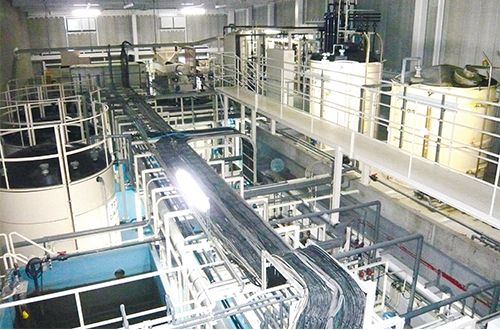
Fujisawa Plant's wastewater processing facility
Prior to releasing wastewater into rivers, MinebeaMitsumi Group plants use their own processing equipment to purify wastewater to within fixed environmental standards. These plants adhere to environmental laws of the countries and localities in which they operate, and independently monitor such wastewater discharges, including regular testing for such metrics as pH1, COD2, BOD3, SS4, and n-hexane extracts5.
- pH: A scale indicating whether substances are acidic or alkaline. pH7 is neutral. pH values below 7 indicate increasing acidity, while values above 7 indicate increasing alkalinity.
- COD (chemical oxygen demand): The amount of oxygen consumed to oxidize organic substances (pollution) in water. COD measurement takes less time than BOD measurement, but is less reliable. COD is generally used as a metric in wastewater management for sea, lake, and marsh waters.
- BOD (biological oxygen demand): The amount of oxygen required for bacteria to consume and decompose organic matter (pollution) in water. Higher values indicate greater degrees of pollution. Measurement takes several days. BOD is generally used to observe effluent water in rivers.
- SS (suspended solids): The volume of substances suspended in water. The higher the number, the greater the degree of water pollution.
- n-Hexane extracts: Substances extracted from oils and detergents that are difficult to volatilize in water using a substance called n-hexane as solvent. In this report they signify mineral oils.
Implementation of Environmental Patrols at Overseas Plants (Thailand, China, Singapore, Cambodia)
Members of the Japanese Group Environment Management Department of the MinebeaMitsumi Group regularly visit overseas plants to implement environmental patrols together with members of the local environment management departments.
In FY2016, we conducted joint patrols at all plants in Thailand, China, Singapore, and Cambodia.
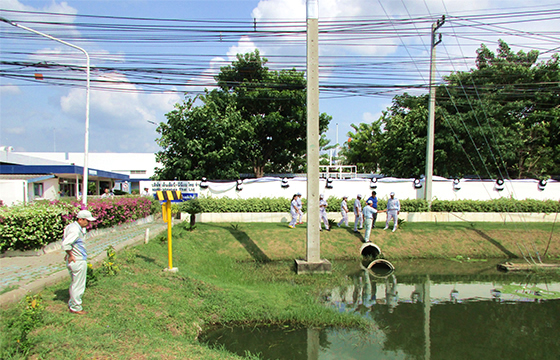
Inspection of drainage at the Ayutthaya Plant, Thailand
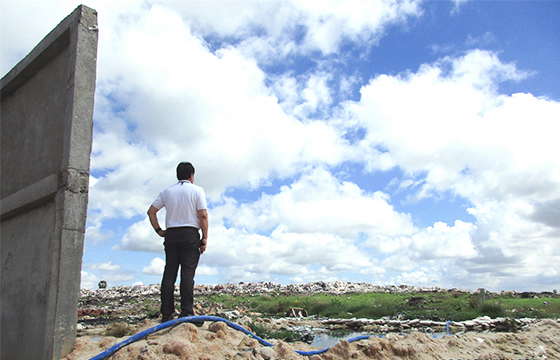
Situation check at waste disposal site for the Cambodia Plant
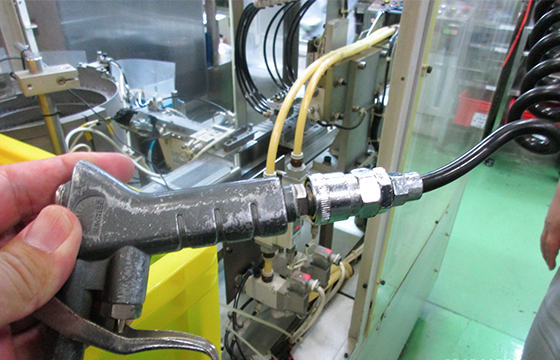
Energy conservation patrol at the Shanghai Plant (facility inspection)
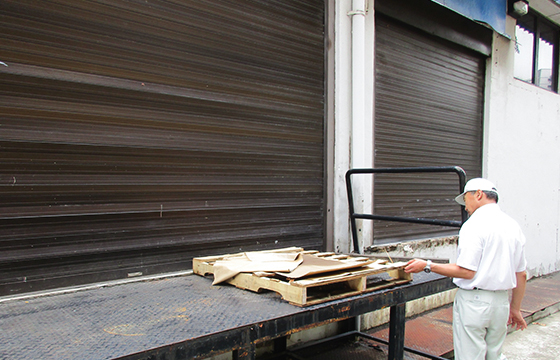
Plant vicinity patrol in Singapore
Investigating Landfill Waste Sites (Japan, Thailand, China, etc.)
At each plant and office, there are types of waste which are difficult to reuse or recycle within the site. In these cases, the waste is disposed of through third-party waste disposal companies.
The MinebeaMitsumi Group selects reliable waste disposal companies and conducts regular inspections of their disposal sites to confirm the status of waste disposal and management. We will continue to cooperate with waste disposal companies to ensure that their waste disposal processes do not generate soil, water, or air pollution.
In July 2016, representatives from Tokyo head office visited Ojisaito Shigyo Paper Corporation, which handles the destruction of confidential documents. The plant destroys confidential documents and recycles them into packaging paper for confectionery and the like. We found that the plant recycles resources while strictly managing transport vehicles and drivers, while preserving the confidentiality of waste documents.

Inspection of the subcontractor by representatives from the Tokyo head office
Operation of Plant Wastewater Zero System (Thailand & China)
The MinebeaMitsumi Group operates plants which use large amounts of water in the processing of manufactured products and take measures to reduce emissions of wastewater.
Our plants purify used water to reduce the level of waste to below standards required by each country and locality before releasing the water into the environment. Despite these measures, we cannot guarantee that the released water has zero impact on the surrounding environment.
At our plants in Thailand and China, which use large amounts of water, we have adopted the "Plant Wastewater Zero System" to reduce to as close to zero as possible the wastewater released and its impact on the environment.
In this system, the plants further purify wastewater that was previously treated and released into the environment, and then reuse the entire amount of wastewater internally at the plant without any external emissions.
Currently, this system is being used by the Bang Pa-in and Ayutthaya plants in Thailand, as well as the Shanghai and Xicen plants in China.

Bang Pa-in Plant "Plant Wastewater Zero System"
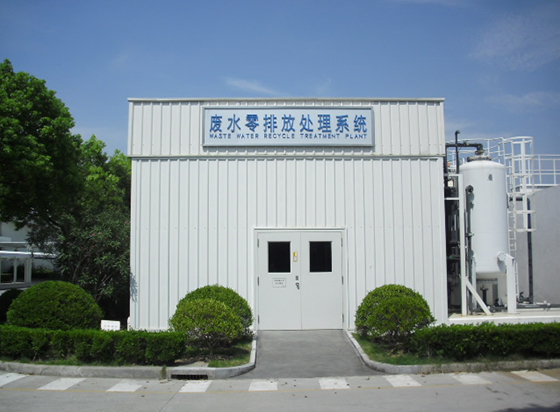
Xicen Plant "Plant Wastewater Zero System" building
Management of PRTR-controlled Substances (Japan)
In accordance with the Pollutant Release and Transfer Register (PRTR) Law, all of our places of business in Japan manage the amounts of PRTR-controlled substances used and transported.
Reported Results for FY2016
| Control number | Substance name | Volume handled | Emission Volumes | Transfer volumes | |||
|---|---|---|---|---|---|---|---|
| Air | Water | Landfill | Waste | Sewerage | |||
| 71 | Ferric chloride | 3.01 | 0 | 0 | 0 | 0 | 0 |
| 349 | Phenol | 1.15 | 0.05 | 0 | 0 | 1.11 | 0 |
| 374 | Hydrogen fluoride and its water-soluble salts | 17.51 | 0.18 | 0 | 0 | 0 | 0.88 |
| 384 | 1-bromopropane | 18.32 | 15.50 | 0 | 0 | 1.40 | 0 |
| 438 | Methylnaphthalene | 3.46 | 0.08 | 0 | 0 | 1.78 | 0 |
| Total | 43.45 | 15.81 | 5.17 | ||||
Management of PRTR-controlled Substances (Japan)
In September 2016, the Karuizawa Plant held its 12th business continuity plan (BCP) training drill.
The drill simulated the impact of an earthquake with an intensity of upper 6 on the Japanese scale of 7 in Matsumoto City and simultaneous quakes directly under Tokyo and along the Nankai Trough. As part of the drills, employees practiced ways to prevent oil spills in the event of a spill inside the plant during such a disaster.

BCP training and oil spill prevention drills at Karuizawa Plant
Chemical Substance Leak Preparedness Training (China)
The Shanghai and Xicen plants in China conduct emergency response training through chemical substance leak simulations. The Environmental Safety Committee at each plant conducts the training to minimize human injury and environmental pollution by taking appropriate measures in the event of a leak. The training is held annually for manufacturing division employees handling hazardous chemicals substances, suppliers of hazardous chemical substances, hazardous materials recovery companies, and cleaning companies.
In April 2016, 38 people (including eight from Suzhou Plant) participated in a training session at the Shanghai Plant. In addition, 35 people participated in training at the Xicen Plant. The sessions, held under the guidance of the Environmental Safety Committee's Chemical Substances Management Group and the responsible fire department, involved on-site training on diffusion prevention with absorbent materials in case of leakage of dangerous chemicals, how to deal with injuries, and the emergency contact procedures.
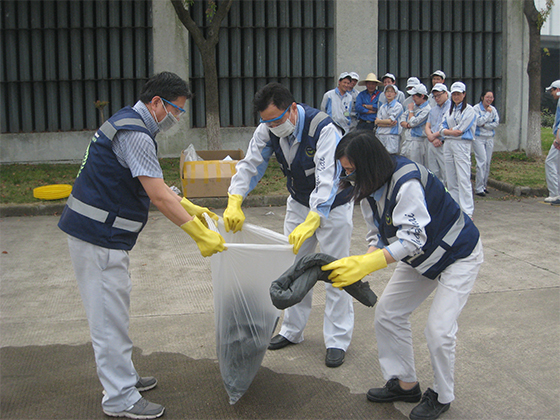
Chemical substance leakage preparedness training session at Shanghai Plant

Chemical substance leakage preparedness training session at Xicen Plant
Chemical Substance Leak Preparedness Training (China)
In May 2016, the Xingdao Plant in China conducted emergency response training through chemical substance leak simulations.
The Environmental Safety Committee conducted training to minimize human injury and environmental pollution by taking appropriate measures in the event of a leak. The annual training was held for a total of 11 manufacturing division employees in charge of bringing hazardous chemicals substances in or out of warehouses. Before the emergency response training, there was a fire drill for all employees at the plant, after which the employees were instructed on the response training.

Training drill
Future Issues and Goals
The MinebeaMitsumi Group conducts business operations in compliance with environmental laws in Japan and around the world, and is proceeding with cleanup work in areas where it has caused environmental contamination in the past.














